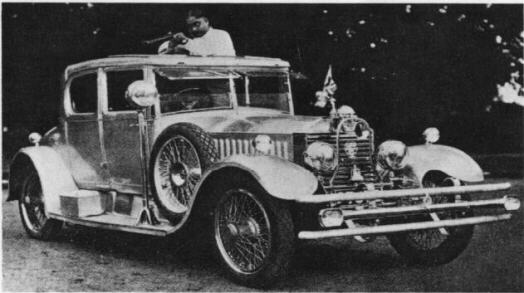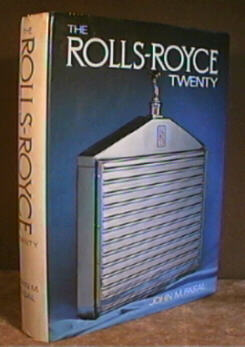Preface
It was in August 1964 that
I first recognised the 20 h.p. model that was to change
my way of life. At that time I was employed in an antique
furniture restoration business in Camden Town, North
London. Regular trips to the Portobello Road (in the days
when bargains could be found) took me past Ledbury Road
where a restorer of paintings had three Rolls-Royce cars
parked outside his shop. In front of a 25/30 h.p. Hooper
limousine and a 20/25 h.p. shooting-brake stood a sadly
neglected 1928 20 h.p. Park Ward saloon with division
(chassis no. GBM 38). Captured by the aura of a quality
car, despite its sorry state, I bargained with its owner
until finally he agreed to accept £100 for it. Through a
local Rolls-Royce owner I met Reginald Burlingham. Reg
had joined Rolls-Royce Ltd.'s London Repair Depot in 1923
and retired as the outside tester in 1947 to form his own
company, Somerton Motors. When Reg saw GBM 38 his first
words of encouragement were `burn it'! Not daunted by
this, I spent an increasing amount of time under his
patient instruction gaining first hand experience of the
small horsepower Rolls-Royce cars. The source of
inspiration for embarking on this project is due in great
part to this accomplished craftsman. To have a keener
appreciation of the 20 h.p. model I made an effort to see
as many examples as I could. I recorded each one. By late
1965 I had listed some seventy-five. After visiting
twenty-three countries and thirteen years later this list
now numbers 1040. Searching out so many Twenties from
palaces to breakers yards was an enjoyable part of the
research, particularly the visits to America, Australia
and India. In the seventy or so books on Rolls-Royce
there is little to be found relating to the Company, its
background and, above all, the people who worked at
`Royce's' during the 1920s. It has been a great pleasure
to meet over fifty employees who had worked in the
Company during the production of the Twenty. What
impressed me was the way they spoke with warmth of the
comradeship and loyalty, the exacting standards and the
stringent testing as well as the discipline that demanded
such attention to detail-for them, those were the `good
old days'. This book does not only look at the car and
its customers, but also at the development of the
Company. A large number of photographs and original
documentation are included, much of which has not been
made available for publication in the past. I hope the
reader will share my gratitude to those dedicated people
who took such pride in the excellence of a product that
bore that magic name ROLLS-ROYCE.
John Fasal,
London,
March 1979.
Contents
Colour Plates
Acknowledgements
Picture Acknowledgements
The Twenty - An Appreciation
Chapter I The Formative Years
Chapter 2 The Twenty Makes Its Debut
Chapter 3 Design
Chapter 4 The Experimental Cars
Chapter 5 The Development of the Twenty
Chapter 6 The Derby Works
Chapter 7 Selling the Twenty
Chapter 8 The School of Instruction and the Repair Depots
Chapter 9 Coachwork on the Twenty
Limousine Coachwork
Saloon Coachwork
Coupe Coachwork
Drophead Coupe Coachwork
Brougham Coachwork
Landaulette Coachwork
Sedanca Coachwork
Cabriolet Coachwork
Two-seater Coachwork
Tourer Coachwork
Chapter 10 Some Unusual Twenties
Chapter 11 The Twenty in India, Australia and the U.S.A.
Chapter 12 Neglected Twenties
Chapter 13 End of an Era
Appendix I The Complete List of the Twenty Chassis
Appendix II 20 h.p. Publications Issued by the Company,
1928-1930
Appendix III Contemporary Road Tests and Reports in the
Motoring Press
Appendix IV Sources of Material Relating to Individual
Twenty Cars
Appendix V Chassis, Body Mounting and Spares. Details
Appendix VI Derby Development Record 1918-1930
Bibliography,
Index of Cars
Index

l925 GPK 33 a special four seater
saloon by C. Wylder & Co. supplied to
H.H. The Maharaja of Bharatpur In April l926.
On a hunting expedition in the Province of Chotonagpur.
The body was
polished aluminium throughout and the petrol tank, frame,
etc. were painted aluminium.
The body cost was £600 and no front wheel brakes were
specified on the order. Features included:
Extra for nickel plating
wheels (6) . £11.10.0.
N/plated Bosch horn in addition to Klaxon . £4.12.6.
R.-R. mascot with flagstaff. £4. 0.0.
N/plated chassis instruments .£4.6.0
Near side and off side spare wheel carriers . £9. 9.0.
Supplying a second battery . £8. 0.0.
A special polished aluminium box to hold 2nd battery.
£5. 5.0.
Changing steering from `Raked' to `Upright' position .
£7. 6.0.
Alterations to body due to changing rake of steering .
£7.18.0.
A set of 6 electroplated beakers in leather case . £3.
2.6.
A quart size Thermos flask. £2. 2.0.
Pyrene fire extinguisher .£3. 0.0.
Liberty Bell .£3.13.6.
Blue flag lamp .£1. 5.0.
A Eural horn attachment for Bosch horn .£2. 5.6.
Blue glass to screen and all windows
A spare set of plain glasses for screen
N/plated buffers-rubber faced-triple bar .£21.15.0.
Parsons chains to rear wheels . £4.10.0.
One pair Lucas sidelamps facing backwards . £2. 2.0.
One pair of small Stephen Grebel headlamps . £15. 0.0.
A special bracket for searchlight . £11. 9.0.
Sliding panel to roof for shooting out of
Pull-out cigar lighter with switch on instrument board.
£2. 2.0.
A Folberth wiper . £4.12.6.
A 2 gallon silver plated water tank fitted in boot .
£15. 0.0.
Filler to petrol tank-vertical . £1. 4.6.
Detachable servants' seat at rear, complete with straps.
£20.15.0.
Rear quarter windows to drop and fitted with window lifts
. £15.15.0.
Carriage of Stephen Grebel lamps from Paris to London .
£5. 3.10
Nickel plated bracket in front of car to accommodate
bell,
ftag lamp, Bosch horn and Stephen Grebel lamps .
£14.14.0.
An engraved panel for switches . £10.0.0
Collecting, packing and shipping to Bombay from London .
£81. 0.0.
Insurance to a value of . £2100.0.0.
15'.3" X 6'.4" X 6'.5" 56 cwt. gross
